CW: Emotional abuse
In my last article, I laid out how RWBY’s sixth volume was everything I’d ever wanted from the series. After the lacklustre outing that was Volume Five, Volume Six was a massive improvement across the board, particularly when it came to narrative structure and pacing. And while Volume Six’s soundtrack wasn’t the shows’ strongest, Jeff and Casey Lee Williams still gave an excellent set of emotional, character-driven songs.
Which, of course, leaves character arcs and fight scenes for this part of my review. Now given my somewhat…negative reviews of Volume Five, I’d understand if some readers expected my second article on Volume Six to be a bit more critical. But in the words of Ruby Rose herself…nope!
Fights
Unlike volumes four and five, it’s hard to pick one standout fight for Volume Six, because frankly, they’re all really good. Rather than have a series of mediocre fights highlighted by a couple of solid ones, the fight scenes in volume six consistently set a high standard. Every fight was well-choreographed, well-animated and was creative in its use of terrain and the character’s weapons. Coupled with the soundtrack, this was a return to form after the dismal Volume Five.
Adam Character Short:
The primary focus of the character short is Adam’s transformation from righteous warrior to monstrous abuser, and the two short fight sequences do a solid job of conveying this. In the first, he’s fighting in self-defence, but in the second he’s actively attempting to murder defenceless opponents. The choreography is great, and the addition of Sienna Khan and Ilia gives the fights variety but also displays how the White Fang sees Adam. Coupled with Lionize, this was a really interesting look into Adam’s backstory.
Train Fight:
The earliest sign of the vastly higher quality volume, this was the first fight featuring a united team RWBY since Volume Three, Chapter One, the train fight had solid choreography, interesting interactions and team-ups between characters, an exciting new species of Grimm to combat, and a thrilling piece of music (Miracle) to accompany it. The only thing that really bothered me was that characters jumping in the air on a moving vehicle should land further down the train – such as in The Wolverine – but didn’t. Asides from that, this was an exciting, creative fight, and a great way to kick things off.
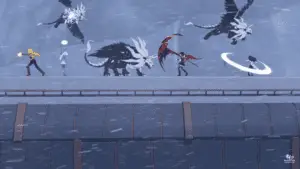
Cinder vs Neo:
After being absent for Volumes Four and Five, Neo returned with a bang for an awesome bar fight with Cinder. While the choreography didn’t quite reach the standard set by Yang vs Neo and Ruby vs Roman and Neo, it was still a very well-done fight sequence. Neo’s use of the surrounding environment, the accompanying music (One Thing), as well as Cinder using her Maiden powers in a more grounded fashion definitely met the expectations of fans for a fight featuring Neo.
Brunswick Farms
While this was more of a chase sequence that a fight, it was still a thrilling experience. The Apathy are easily some of the scariest Grimm of the entire series, and the way they drained team RWBY and Maria to the point of near-death was haunting, particularly due to the sound effects employed. The sequence really shined when Ruby used her silver eyes, with the muffled audio, Maria’s dialogue, and the zoom in on Ruby’s face making for a truly awesome moment.
Maria Flashbacks
RWBY’s flashback fight scenes are always impressive, and this one was no exception. Excellent choreography aside, the fight was very creative in the use of Maria’s weapons, especially with her use of gravity Dust, both in her aerial fight with the Nevermore, and her ground fight with Tock and her crew. The fight with Tock also managed to be incredibly brutal and intense, with the ticking clock effect amplifying the tension of the scene.
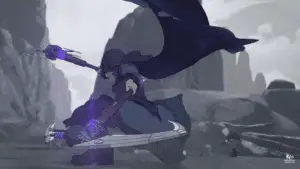
Ruby & Co. vs Cordovin
While Cordovin didn’t make for a particularly intimidating villain, the battle between her and Ruby, Weiss, Jaune, Nora, Ren, Oscar, Qrow and Maria was certainly fun to watch. The variety of tactics exploited to disable Cordovin’s Colossus mech made the fight really interesting, as every character used all of their abilities to match an opponent that drastically outclassed them in size and firepower. The attacks from various angles, the shifting strategies of our heroes and Cordovin, Ruby’s speech, as well the catchy Big Metal Shoe made for a great fight, albeit not as good as…
Blake and Yang vs Adam
If I had to pick one fight as the best of Volume Six, Blake and Yang’s final showdown with Adam would be the clear choice. This fight was the culmination of three volumes worth of character development for Blake and Yang, and it did not disappoint. The fight was spread out over three distinct terrains, but that didn’t lessen the quality in any way. I could easily spend an article dissecting the tower and forest portions of the fight, from the evocative imagery of Blake’s Beauty and the Beast character basis in the tower to how every blow makes the fight more intense, to Adam’s victim-blaming dialogue while chasing Blake.
The fight is absolutely brimming with character development. From the more mature, intelligent tactics displayed by Yang, Blake calling out Adam on his abuse, the two girls fighting side by side after so long apart, Gambol Shroud being broken by Adam then the girls finishing him by stabbing him with the broken blades, abusive Adam being run over by a motorbike that shares a name with a positive and loving relationship name…all of these little nuggets of character development added to the incredible choreography to give a fantastic finale to three volumes of storytelling.
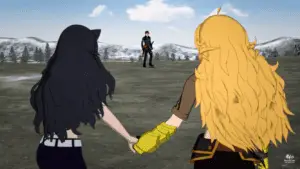
Everyone vs Leviathan
While Blake and Yang vs Adam was a finale to their arcs across the last three volumes, the battle against the Leviathan served as a finale for volume six, though that didn’t diminish the quality in any way. An animation glitch when Cordovin attacked the petrified Leviathan did drag the fight down a little, it otherwise boasted the same strengths of the mecha fight, with the characters using the weapons, Semblances and strategies to take the Leviathan down.
The star of this fight is Ruby though. While her strategizing and clever use of the Relic were great, she brought an emotional side to this fight. I’ve criticised the show numerous times for the way it’s used its protagonist, but Volume Six was a colossal improvement on this. I’ll go into it more in the character section below, but this fight firmly placed Ruby as the protagonist of the series. She takes charge in a perilous situation, uses the friendships she’s formed to properly use her silver eyes, and is the who one truly saves the day. This was exactly what the character needed, and it was all seamlessly incorporated into the fight – and don’t even get me started on the fantastic use of Indomitable.
Character
Okay, so this was the weakest part of the volume, but it was still a tremendous improvement over Volume Five, and a step in the right direction for the series as a whole. While the show still struggles in giving each of the four protagonists a definitive emotional arc for each volume, Volume Six did do a much, much better job. On top of that, some much-needed backstory and character development was provided to other lead characters this volume.
Note: Blake and Yang’s arcs were heavily intertwined this volume. I have done my best to analyse their shared moments with respect to each character’s personal story, although that will make some parts of this analysis a little repetitive.
Salem
Salem doesn’t really undergo any character development this volume, but given that V6C3 The Lost Fable was a twenty-six-minute character study explaining her backstory, I’d be remiss to leave her out.
The Lost Fable shows Salem’s transformation from a sweet, kind young woman into the monster she is in the series. The psychological impact of Ozma/Ozpin’s death, being cursed with immortality by the gods, and the loneliness that came with being the last human left on Remnant is explored and strung together to make her transformation feel natural. However, the episode doesn’t explore what the pools of Grimm did to her mental state in great detail, so her hatred towards Ozpin and desire to replace humanity with a better species kind of come out of nowhere. While Ozpin’s ‘betrayal’ by taking their children away once he realised what Salem had become does provide a reasonable motivation for her enmity towards him, it did feel a bit rushed. I still feel like I don’t know the whole story.
Needless to say, I found The Lost Fable a solid backstory for Salem. It did fall a bit short in the end, but I did finish the episode understanding Salem’s motives a lot better. Her manipulative nature and her animosity towards the Gods and Ozpin were fleshed out fairly well. One line that really stuck with me was, “She cursed the gods, she cursed the universe, she cursed everything. Everything but herself.” Of everything revealed about Salem, I found this to be the most compelling and believable motive for her actions. Accepting your own flaws is without a doubt one of the hardest things a person can do. Being stuck in a cycle of denial is something that happens around the world every day, so having this be the driving force for her actions is very understandable. It’s one of the most relatable motives I’ve seen in media, and that’s what truly cements Salem as a great villain.
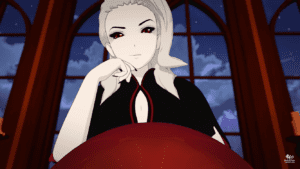
Oscar/Ozpin
Oscar/Ozpin’s arc in volume six was a bit off a letdown, all things considered. For starters, while The Lost Fable did a very good job showing Salem’s descent into evil, it reveals that in his first life as Ozma, Ozpin did nothing wrong. His actions were quite reasonable, and I think he made the right decisions given the circumstances.
I mention this because volume six is clearly trying to portray Ozpin as some sort of morally ambiguous figure, similar to Dumbledore. The issue is that only Ozpin’s present actions are problematic. While there’s definitely a case to be made regarding how much blood is on his hands after millennia of conflict with Salem, the only thing that really gets focus is Ozpin keeping secrets from his allies. That’s not uninteresting, particularly when it’s revealed he actually doesn’t have a plan to stop Salem, but in terms of establishing Ozpin as morally ambiguous, the story fell a bit flat.
Now the reaction by Ruby and co. to this information was interesting…at first. Their loss of faith in Ozpin was interesting to watch, particularly during their stay in Brunswick Farms, where the Apathy Grimm brought these emotions to the forefront. However, what Ruby and co. plan to do about Salem is never really answered. The loss of faith in Ozpin is brought up again when they reunite with JNR, but at no point do the main four characters try and find a new motive to keep moving forward with their quest. Even when Weiss directly asks Ruby about it, she doesn’t give a clear answer.
I understand that the show is trying to position Ruby as the motivating factor for the protagonists to continue their mission, but volume six doesn’t do a great job of displaying that, with the exception of Qrow and JNR, who I’ll get to in a minute. There was a real chance to explore the lead characters’ response to this news by digging into what drives each of them, but the show never takes it. This is particularly frustrating in the case of Oscar, whose concerns about losing his identity are ‘solved’ by him getting a new set of clothes. Which was…frustrating, to say the least. I’ve never been a fan of off-screen character development, and this instance of it certainly didn’t change that.
I mean I guess I can take some solace in the revelation in episode thirteen that Ozpin was actually watching everyone the whole time, possibly implying he’s handing on the torch to a new, worthier generation and allow Oscar to walk his own path, which Oscar seemed to be working towards by refusing Ozpin’s help in battle in episode one, but that’s just speculation. The fact that they didn’t explore Oscar’s reaction to Ozpin forcibly taking over his body during the fight against Hazel, with them just back to being buddy-buddy at the start of the volume, was another weak spot.
Overall, I thought the Oscar/Ozpin arc had a promising start, but ultimately there were a lot of missed opportunities in the way it affected the Oscar and most of the other characters.
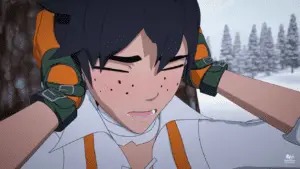
Qrow
Despite my issues with the Ozpin/Oscar storyline, Qrow’s reaction to these revelations was handled very well. He loses faith in Ozpin, falls into a depressive state, and his drinking picks up to the point where he’s a liability to the team. And honestly, I don’t really have that much in the way of criticism for his arc. He has a completely natural reaction to having his life’s purpose upended;
“No one wanted me. I was cursed. I gave my life to you because you gave me a place in this world. I thought I was finally doing some good.”
This volume highlighted the more tragic aspects to Qrow’s character. He may be the funny, cool uncle, but his Semblance constantly puts those he loves in danger, and forces him to stay away from them. Finding purpose with Ozpin, then losing that purpose, emotionally shatters him.
When Qrow was introduced in Volume Three, I was uncomfortable with the light-hearted take on his alcoholism. But as the series progressed, it’s become increasingly obvious that the funny, drunk uncle persona is a method Qrow uses to numb the pain of solitude and self-loathing, and volume six showcased this more than ever, with his alcoholism nearly getting him killed at Brunswick farms and making literal ray of human sunshine Ruby angry.
Ultimately though, it’s Ruby who saves Qrow. When she starts taking charge and leading the group, her efforts guide Qrow out of his depression. V6C9 shows Qrow at his lowest point, but Ruby’s outburst at his cynicism snaps him out of his self-loathing. It’s not instantaneous, as he still freezes up when Cordovin comes after the group, but I liked this detail. Dealing with depression is far from an overnight process, and having Qrow doubt himself shows that. Not to mention, it makes his overall arc flow much better. Unlike Salem and Ozpin, whose character arcs jumped over important points, every beat of Qrow’s arc organically progressed to the next. When the volume ends with Qrow forsaking drinking, it’s the natural conclusion to a great character arc.
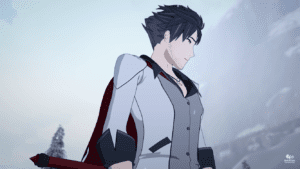
Jaune
Jaune has been one of the more controversial characters in RWBY, with sexist storytelling tropes affecting his storylines and character development right from the get-go. While volumes three and four seemed to remedy this issue, the writers slipped up in volume five, with the final four episodes featuring an unpleasant amount of manpain in Jaune’s scenes.
Thankfully, Volume Six got things back on track. Although Jaune’s character development only occurs in two episodes – V6C8 Dead End and V6C9 Lost, it’s still an important moment for his character. While this character development is due to the death of a female character – Pyrrha – unlike Weiss, this wasn’t about Jaune’s character growing in reaction to a woman being injured.
The scene in question is when Jaune finds a statue of the late Pyrrha while out looking for Oscar, who Jaune assaulted after learning about Ozpin’s lack of plan for dealing with Salem. There, he meets a woman who is all but stated to be Pyrrha’s mother, and the two discuss his late friend.
What makes this scene works so well is that it cements Pyrrha’s legacy, and allows Jaune to say goodbye, but to also find a reason to move forward. Jaune and Pyrrha’s mother discuss everything that made Pyrrha who she was. The improvement over Volume Five is that while Pyrrha’s death changed Jaune, it wasn’t about him – her fight with Cinder was the conclusion to her arc, not a way of propelling Jaune’s.
Jaune: I think…I think she knew that she wasn’t going to win, that she might not come out alive. But…she also knew that she was the only one that could try.
Ren: So she did.
Nora: Maybe we should too.
Jaune: Yeah, we should.
I could easily transcribe the whole scene, because every line is a reminder of who Pyrrha was. Jaune, Nora, and Ren find a way to move forward through her ideals, commemorating their lost teammate along the way. The scene gave a solid motivation for Jaune and his team, and also gave him closure. When he reunites with everyone, he apologises to Oscar, and is the first to suggest a plan to get to Atlas, showcasing his newfound drive. Overall, a short, but great character arc.
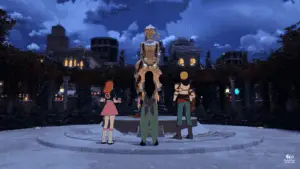
Yang
Yang’s arc this volume had its ups and downs. It didn’t get off to the best start, when she got over her animosity towards Blake way too quickly. I get that was the point of the back half of volume five, but there’s no point where the two explicitly discuss the issue of Blake leaving Yang after the Fall of Beacon, a topic a bit too important to brush over. There casual banter during the train fight didn’t make things any better.
Her arc from the crash of the Argus Limited to the events of Brunswick Farms went well, for the most part. Her reaction to Ozpin continuing to withhold vital information was a natural progression from volume five, where she started challenging authority figures and thinking for herself. She was even ready to fight Qrow to protect Ruby.
Her loss of faith in their mission transporting the Relic of Knowledge became even more apparent during her stay at Brunswick Farms, where she outright suggests disposing of the Relic. Technically, I can’t count this as genuine character development because it was influenced by the Apathy Grimm, but it was still interesting seeing Yang sink so low. Her conversation with Blake, also influenced by the Apathy, brought out her continuing struggle about her traumatic experience with Adam. While these actions may have been Apathy-induced, they were still interesting to watch…until the conclusion.
Yang’s answer to the question of what they should do about Ozpin’s lack of a plan is to simply keep going until they get the Relic to Atlas, to keep it safe. In the short term that’s fine, but long term? What’s her motivation to continue their mission? Like I said in my Ozpin/Oscar section, this was a great opportunity to dig into Yang’s character, but it was missed.
However, her arc really picks up in the latter half of the volume with the long-awaited rematch between Yang and Adam. The excellent choreography of the fight aside, this was a great conclusion to Yang’s journey over the last three volumes. Losing her arm saw a dramatic change in Yang’s character, and all of this came out in the fight. She was more cautious and patient, not falling for the same traps that she did during her last fight with Adam. While her declaration, “I may not be faster. But I’m smarter,” felt a little on the nose, the fight was a great display not only of her maturity, but that her trauma wasn’t something that would go away easily – her continuing hand tremors was a brilliant touch. The fight also resolved her friction with Blake, as the two united to overcome the man who had done so much damage to their lives. Watching the two fight side-by-side, hold hands, and hold each other after killing Adam was a fantastic way to end the volume, and quite possibly signal the beginning of a romance between the two.
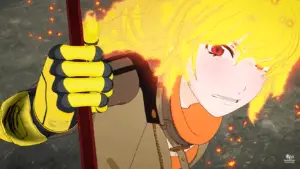
Blake
Blake’s arc in volume six has similar highs and lows to Yang’s. Her quick reconciliation with Yang was a bit fast, especially given that unlike Yang, she didn’t spend part of volume five working through her complex feelings for her partner. Her lack of meaningful growth out of learning Ozpin has no plan for defeating Salem was also frustrating. However, once her arc turned to dealing with Adam, things really got interesting.
Adam’s strong, but his real power comes from control. He used to get in my head, make me feel small. But now I see he just wanted to pull me down to his size.
Adam Taurus is an abusive monster, and for Blake to recognise that is a great sign of her growth. Their confrontation towards the end of the volume showed off even more of these abusive tendencies, with pretty much all of Adam’s dialogue victim-blaming Blake. This behaviour is a well-known trait of abusive relationships, and the show does a really, really good job of accurately depicting this form of emotional abuse. While this may be unsettling, watching Blake stand up to Adam’s behaviour and calling him out on it was another great display of how much she’s grown;
A: I wouldn’t have to be doing this if you’d just behaved! But you’re selfish! You’re a coward!
B: You’re delusional.
Adam tries pulling this on Yang as well, which is equally ineffective. While perhaps more time should have been invested into Blake emotionally preparing for her eventual clash with Adam, it was still an emotionally-charged resolution to their conflict. Having her defeat her abuser by uniting with Yang was the triumph of a healthy, loving and caring relationship over an abusive one was deeply satisfying to watch, not only from a storytelling perspective but for anyone who’s been in Blake’s shoes.
Having her and Yang kill Adam was a shock, but Blake breaking down in tears afterward was another very accurate representation of the emotional turmoil that comes with breaking away from an abusive relationship. Yang comforting her was a fitting finale to the conflict with Adam, further symbolizing Blake moving from an abusive to a loving relationship. A romantic relationship between the two hasn’t been confirmed yet – it seems her kissing Sun was more of a gesture of thanks – but given the way the two behave in Volume Seven, their relationship seems to be heading in that direction.
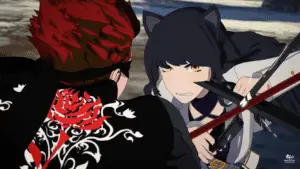
Weiss
So…what was Weiss’ arc this volume?
I don’t enjoy criticising RWBY, especially when so much of this volume worked, but Weiss’ ‘arc’ in Volume Six was just…meh.
It has the same problems that Blake and Yang do in establishing her motive after the revelations about Ozpin, but unlike them, she doesn’t later deal with any major issues. There are brief moments that show she’s grown – her closer relationship with Ruby, her reluctance to return to Atlas, and when she stands up for Blake in the face of Cordovin’s racism – but they’re just moments. Small moments that show development don’t make a character arc. True, Blake and Yang’s character moments were mostly a result of growth, but that was a culmination of the work they did in Volumes Four and Five. Weiss doesn’t have that same foundation to go on.
What’s more frustrating is that there was ample opportunity for Weiss this volume. Returning to her abusive father in Atlas should be a major deal, even for a character who doesn’t share her innermost fears too often. What could and should have been an important moment in her arc – finding the courage to go back to an abusive household – is almost entirely skipped over, bar a few lines between her and Ruby. Overall, Weiss was severely underused this volume. Hopefully, things will pick back up in Volume Eight.
That’s not a typo, folks. Volume Seven review will be salty.
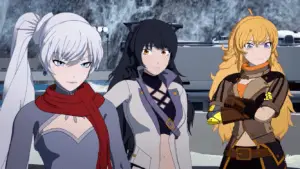
Ruby
One of the weakest points of the RWBY series has consistently been its main character and namesake, Ruby Rose. From Volumes One through Five, Ruby barely felt like a protagonist – she was often pushed to the sidelines, we rarely if ever saw her perspective on events, and her character development mostly fizzled out after Volume One.
Now I had some hope that Volume Six would remedy this issue, in part due to her conversation with Oscar in volume five about Penny and Pyrrha, as well as a Reddit AMA by writers Miles Luna and Kerry Shawcross after Volume Five where they stated their intention to write more emotional moments featuring Ruby.
But what we got in Volume Six completely blew me away. Right from chapter one, Ruby took centre stage. She stepped up and took the role of the group’s leader, guiding her friends and rallying morale when needed. This was especially evident when Qrow, who had been in charge, for the most part, the last two volumes, sunk into depression and the group lost faith in Ozpin’s mission. Ruby kept the team moving, and without her, I sincerely doubt they would have made it to Argus.
Argus itself provided more development for Ruby. She finally asked about her silver eyes, taking lessons from Maria after two volumes barely touching on her incredible gift. When Qrow hit rock bottom, she snapped and called him out, pushing her friends to keep moving forward. Then when he panicked and almost sunk into despair, she comforted and reassured him. She called out Cordovin, and tried to reason with her when others wouldn’t.
Ruby: I’m a Huntress, my team and I are heading to the Leviathan and can weaken it for you to attack.
Jaune: We can?
Ruby: I can.
I’m listing all of this because it’s exactly what I’ve been wanting from the series – for Ruby to be the hero. She’s the protagonist, she’s the one who should be the driving force behind the plot, and before volume six, she wasn’t. Finally, she’s stepping into the spotlight and being the main character. This doesn’t make up for the last five volumes and the series still hasn’t explained why she’s so determined to continue Ozpin’s mission, but I’ll always give credit where it’s due.
Earlier, I said that the fight against the Leviathan firmly placed Ruby as the protagonist of the series. What makes that fight so special is that it’s the season finale, and Ruby is the one who saves an entire city. The shot of her gazing over Argus is one of my favourite of the show because it’s the culmination of a volume’s worth of work to put Ruby where she belongs – the hero of Remnant, and the hero of the story named after her.

Overall, volume six knocked it out of the park. Plot, music, fights, character – the show took it to another level this volume. RWBY really came into its own with these thirteen episodes, and I’m immensely grateful to everyone at Rooster Teeth for making this series the best possible version of itself.
Volume 7 review will come out after the V7 soundtrack is released.
Images courtesy of Rooster Teeth Productions and YouTube

